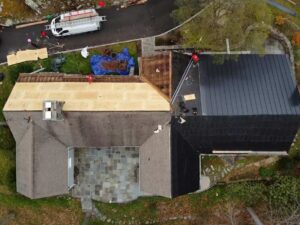In the evolving landscape of building materials and technology, metal roofing stands out for its durability, energy-efficiency, and sleek aesthetic. However, homeowners and businesses considering metal for their roofing often express concerns about how it might affect cell phone reception. Gunner Roofing, with our commitment to providing not just superior roofing solutions but also informed insights into the implications of these choices, is able to shed light on the realities behind metal roofs and cell phone signal reception.
Understanding cell phone signals
To grasp how metal roofs impact cell phone reception, it’s first essential to understand how cell phone signals work. Cell phones communicate using radio waves, a type of electromagnetic radiation, to connect with cell towers. These signals are similar to those used for radio and television but operate at a different frequency. The strength and quality of cell phone reception depend on several factors, including distance from the nearest cell tower, the presence of physical obstacles, and the materials used in construction around you.

The myth of metal roofs and signal blocking
The apprehension surrounding metal roofs and their potential to disrupt cell phone signals is rooted in fundamental principles of electromagnetic interference (EMI). EMI occurs when external electromagnetic fields affect the electrical circuits of a device, potentially degrading or interrupting its performance. Since metal is a conductive material, it has the inherent capacity to reflect and absorb electromagnetic waves, including the radio waves that cell phones use to communicate with cell towers. This characteristic of metal could, in theory, result in weaker cell phone signals for individuals under or around a metal roof as the signal might be reflected away or absorbed before it reaches the phone.
However, this concern oversimplifies the interaction between electromagnetic waves and building materials, particularly in the context of modern telecommunications. Today’s cell phone signals are engineered to be resilient, utilizing a range of frequencies and technologies to ensure reliable penetration through various obstacles, including different types of building materials. This robustness is a key feature of cellular networks, designed to maintain service in a wide array of environments and conditions.
The impact of a metal roof on cell phone reception, therefore, is far less dramatic than many assume. Several factors contribute to this minimized impact:
- Frequency bands: Modern cell phones operate across multiple frequency bands. Some of these frequencies are better at penetrating solid materials than others. Cellular service providers design their networks to take advantage of these properties, ensuring that even if some signals are reflected or absorbed by a metal roof, others can still reach the phone.
- Network density: The density of cell towers and the advanced configuration of cellular networks help mitigate potential signal loss. With towers strategically placed to cover service areas effectively, the chances of a signal being completely blocked by any single obstacle are reduced. Even if a metal roof deflects some of the signal, the overall network design ensures that alternative paths for signal transmission are available.
- Signal reflection as an advantage: In some cases, the reflective properties of a metal roof can actually enhance signal reception inside a building. Reflective surfaces can redirect signals into the building from different angles, potentially increasing the likelihood that a signal finds its way to your phone by bouncing off the metal roof and into various entry points.
- Technological solutions: Technologies such as multiple input multiple output (MIMO) antennas in smartphones and cell towers utilize the principle of signal reflection to improve reception. By sending and receiving multiple signals simultaneously, these systems can exploit reflections (including those off metal surfaces) to enhance signal strength and quality.
In practical scenarios, the difference in signal quality with a metal roof as opposed to other roofing materials is often negligible. Factors such as the user’s distance from the nearest cell tower, the specific design and installation of the metal roof, and the presence of other materials within the building’s structure play a more significant role in affecting cell phone reception. The concern over metal roofs significantly disrupting cell phone reception should be viewed as a manageable challenge rather than a prohibitive drawback.

Enhancing cell reception in your home
Despite the minimal impact metal roofs have on cell phone reception, there might still be scenarios where signal strength within a home is less than ideal. This could be due to a variety of factors unrelated to the roofing material, such as the home’s location relative to cell towers, the construction materials used in walls and windows, or even the natural landscape. Fortunately, there are several effective strategies homeowners can employ to boost cell reception within their homes, ensuring strong and consistent connectivity.
- Cell phone signal boosters: One of the most straightforward solutions to improve cell reception is the installation of a cell phone signal booster. These devices capture weak outside signals via an external antenna, amplify the signal, and then rebroadcast it inside the home. Signal boosters are particularly effective in areas where the external signal is weak but not entirely absent. They work with multiple cell phone carriers and can enhance the signal strength for calls, texts, and data usage.
- Femtocells: Also known as microcells or network extenders, femtocells are another powerful option for improving cell reception. These devices act like mini cell towers by connecting to the home’s broadband internet service and converting it into a cellular signal. Femtocells are carrier-specific, meaning you’ll need to get one that’s compatible with your cell phone provider. They’re especially useful in areas with very poor or no cell coverage, as they rely on your internet connection rather than an existing cell signal.
- Wi-Fi calling: Most modern smartphones and cell phone carriers support Wi-Fi calling, a feature that allows you to make and receive calls and texts over a Wi-Fi network instead of using the cellular network. Activating Wi-Fi calling can significantly improve call quality and reliability inside your home, particularly if your Wi-Fi signal is strong and stable. This solution requires no additional equipment and can be a simple toggle in your phone’s settings.
- Optimize home layout: Sometimes, the placement of furniture and electronic devices can impact signal strength. Large metal objects and electronic equipment can interfere with cell signals. Experimenting with different layouts or moving the location where you commonly use your phone within the house can help find spots with better reception. Additionally, moving closer to windows or areas with less structural interference from materials like concrete or steel can improve signal reception.
- External antennas: For homes in particularly challenging environments, such as very rural areas or locations surrounded by significant natural or man-made obstacles, an external antenna can be a viable solution. External antennas are mounted outside the home and are designed to capture cell signals more effectively than a smartphone. When connected to a signal booster, they can significantly enhance the strength of the incoming signal before it is amplified and redistributed within the home.
Implementing a solution
When deciding on the best approach to improve cell reception in your home, consider the specific challenges you’re facing. The effectiveness of each solution can vary based on your location, the construction of your home, and the cellular network you’re using. It may be beneficial to start with the simplest solutions, like enabling Wi-Fi calling, before investing in more complex fixes such as signal boosters or femtocells.
By understanding the options available and taking proactive steps to enhance cell reception, homeowners can enjoy improved connectivity and the benefits of strong and reliable cell phone communication, regardless of their roofing material or location.
The bottom line
The notion that metal roofs significantly impair cell phone reception is largely a myth. While it’s true that metal can reflect and absorb radio waves, the impact on signal quality for the average homeowner or business is minimal. Factors such as distance from cell towers, other building materials, and the surrounding environment play a more significant role in determining cell phone reception quality.
At Gunner Roofing, we understand the importance of staying connected. That’s why we’re committed to providing roofing solutions that not only meet the highest standards of quality and durability but also consider the modern lifestyle needs of our clients. If you’re considering a metal roof for your home, you can rest assured that connectivity remains a priority in our designs and installations.
While it’s important to consider all aspects of a building material’s impact, concerns about metal roofs significantly affecting cell phone reception should not deter you from considering them for your next project. With the right approach and technologies, metal roofing can offer the best of both worlds: unparalleled protection and aesthetics without compromising on connectivity.
